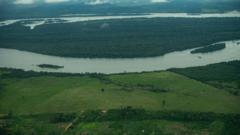Citizens of Australia hold significant influence over global climate change due to their high per capita emissions and coal exports, with the leading political parties offering contrasting energy policies ahead of the elections.
Australia’s Upcoming Election: A Crucial Decision for Climate Policy

Australia’s Upcoming Election: A Crucial Decision for Climate Policy
As Australia prepares for its national elections, the future of the nation’s energy policy and climate change stance hangs in the balance.
As Australia approaches its national elections, the stakes for climate change have never been higher, particularly for a nation that ranks among the largest per capita greenhouse gas emitters globally. The forthcoming vote will see citizens choose between two parties with dramatically different visions for the future energy policy. The election, set to take place on Saturday, has climate change as an underlying issue, though polls suggest it may not dominate voter concerns.
Australia stands out not only as a major consumer of fossil fuels but also as one of the leading exporters of coal and natural gas, catering to energy-hungry Asian markets. The current political landscape highlights a stark division in climate and energy approaches from the two main parties: the Labor Party and the Liberal-National Coalition. Both have acknowledged the need for an energy transition, yet their plans diverge significantly.
A critical factor in the debate surrounds the aging coal power plants, which provide a significant portion of Australia's electricity. According to Andrew Macintosh, a professor specializing in environmental law and policy at the Australian National University, the retirement of these plants is overdue—regardless of climate concerns. The Labor Party advocates for an aggressive expansion of renewable energy sources, while the conservative coalition leans towards nuclear energy as part of their strategy.
Macintosh notes that both plans could lead to reduced emissions, yet he raises questions about the feasibility of nuclear power, pointing out that construction can take over a decade. In contrast, renewable energy technologies can be deployed much more rapidly. This raises important questions about the continued reliance on coal during the transition period, potentially leading to prolonged emissions and costs associated with maintaining aging infrastructure.
As the nation prepares to cast their votes, the decision Australians make could have profound implications, not only for their own environmental future but also for the global climate landscape.




















